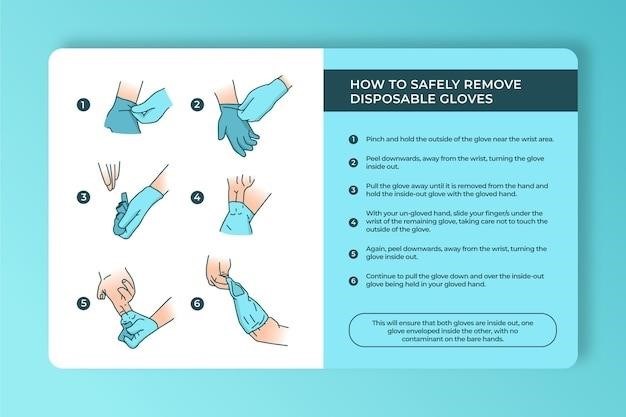Radial Nerve Palsy Exercises PDF⁚ A Comprehensive Guide
This comprehensive guide provides a detailed overview of radial nerve palsy, including its causes, symptoms, and the importance of exercises in recovery․ It covers a range of exercises, including stretching and strengthening exercises, designed to help individuals regain function and reduce pain․ The guide also offers valuable tips for effective exercise and concludes with insights on the overall importance of rehabilitation in managing radial nerve palsy․
Understanding Radial Nerve Palsy
Radial nerve palsy, also known as radial neuropathy, is a condition that occurs when the radial nerve, one of the major nerves in the arm, is damaged or compressed․ This damage can lead to weakness, numbness, and tingling in the muscles of the hand, forearm, and upper arm․ The radial nerve is responsible for controlling the movement of the wrist, fingers, and thumb, as well as providing sensation to the back of the hand․ Radial nerve palsy can result from various causes, including trauma, compression, or entrapment of the nerve․ It is crucial to seek medical attention if you experience any symptoms related to radial nerve palsy, as prompt diagnosis and treatment can improve the chances of a full recovery․
Causes of Radial Nerve Palsy
Radial nerve palsy can stem from a variety of causes, ranging from direct injuries to chronic compression․ One common cause is trauma, such as fractures of the humerus (upper arm bone), dislocations of the shoulder, or direct blows to the arm․ These injuries can directly damage the radial nerve, leading to its dysfunction․ Another frequent cause is compression, often referred to as “Saturday night palsy․” This occurs when the nerve is compressed for an extended period, such as when someone sleeps with their arm resting over the back of a chair․ Additionally, radial nerve palsy can arise from entrapment syndromes, where the nerve is compressed at specific points in the arm, such as at the elbow or in the radial tunnel․ Less common causes include tumors, infections, and certain medical conditions like diabetes․ Understanding the underlying cause of radial nerve palsy is essential for determining the appropriate treatment plan and ensuring a successful recovery․
Symptoms of Radial Nerve Palsy
The symptoms of radial nerve palsy can vary depending on the severity and location of the nerve damage․ A hallmark symptom is weakness or paralysis of the muscles in the back of the forearm and hand․ This can result in difficulty extending the wrist and fingers, making it challenging to grasp objects or perform tasks requiring fine motor control․ Another common symptom is a “wrist drop,” where the hand hangs limply at the wrist due to the inability to extend it․ Individuals may also experience numbness or tingling in the hand and fingers, particularly on the back of the hand and thumb side․ In some cases, pain can be present, particularly in the forearm or elbow․ The intensity and duration of these symptoms can vary depending on the underlying cause and the extent of the nerve damage․ If you experience any of these symptoms, it’s crucial to consult a healthcare professional for proper diagnosis and treatment․
Importance of Exercises

Exercises play a crucial role in the recovery process for radial nerve palsy․ They help to improve muscle strength, flexibility, and coordination, which are essential for regaining function and reducing pain․ Regular exercise stimulates the nerve and muscles, promoting nerve regeneration and preventing muscle atrophy․ Stretching exercises help to increase range of motion and reduce stiffness in the affected hand and wrist, while strengthening exercises target specific muscle groups to enhance their ability to contract and perform tasks․ By engaging in a tailored exercise program, individuals with radial nerve palsy can enhance their overall recovery, reduce pain, improve their ability to perform daily activities, and improve their quality of life․ It’s important to note that exercise should be performed under the guidance of a qualified healthcare professional to ensure proper technique and prevent further injury․ They can create a personalized program that meets individual needs and goals․
Exercises for Radial Nerve Palsy
A comprehensive exercise program for radial nerve palsy typically includes a combination of stretching and strengthening exercises․ Stretching exercises focus on improving range of motion and flexibility in the affected arm and hand, while strengthening exercises aim to build muscle strength and endurance․ Examples of stretching exercises include wrist extension stretches, finger extension stretches, and forearm supination stretches․ Strengthening exercises may involve wrist curls, finger extensions, and grip exercises using resistance bands or weights․ It’s crucial to start with light resistance and gradually increase the intensity as strength improves․ Regular practice of these exercises, along with proper technique and guidance from a healthcare professional, can significantly contribute to the recovery process and help individuals regain functional use of their affected hand and wrist․
Stretching Exercises
Stretching exercises play a crucial role in radial nerve palsy rehabilitation by improving range of motion and flexibility in the affected arm and hand․ These exercises help to lengthen tight muscles, reduce stiffness, and promote blood flow to the area․ Here are some common stretching exercises recommended for radial nerve palsy⁚
- Wrist Extension Stretch⁚ Gently bend your wrist upward as far as possible and hold for 15-30 seconds․ Repeat this exercise 5-10 times․
- Finger Extension Stretch⁚ Extend your fingers as far as possible, keeping them straight and together․ Hold the position for 15-30 seconds and repeat 5-10 times․
- Forearm Supination Stretch⁚ With your arm extended, turn your palm upward and hold for 15-30 seconds․ Repeat this exercise 5-10 times․

It’s essential to perform these stretches slowly and gently, avoiding any pain or discomfort․ You can gradually increase the duration and intensity of the stretches as your flexibility improves․ Remember to consult with a physical therapist or other healthcare professional for personalized guidance and to ensure proper technique․
Strengthening Exercises
Strengthening exercises are vital for restoring muscle strength and function in the affected arm and hand after radial nerve palsy․ These exercises target the muscles that are weakened or paralyzed due to the nerve injury․ Here are some examples of strengthening exercises commonly used for radial nerve palsy⁚
- Wrist Extension Resistance⁚ Hold a light weight or resistance band in your hand, palm facing down․ Slowly bend your wrist upward against the resistance, then slowly lower it back down․ Repeat this exercise for 10-15 repetitions, 2-3 times a day․
- Finger Extension Resistance⁚ Place your fingers on a table or flat surface with your palm facing up․ Slowly lift your fingers off the surface, keeping them straight and together․ Hold for a few seconds, then lower them back down․ Repeat for 10-15 repetitions, 2-3 times a day․
- Forearm Supination Resistance⁚ Hold a light weight or resistance band in your hand, palm facing down․ Slowly turn your palm upward against the resistance, then slowly lower it back down․ Repeat for 10-15 repetitions, 2-3 times a day․
It’s important to start with light weights or resistance and gradually increase the intensity as your strength improves․ Avoid any pain or discomfort during these exercises․ Regular practice of these exercises will help build muscle strength, improve grip, and enhance overall hand function․
Tips for Effective Exercise
To maximize the benefits of exercises for radial nerve palsy, it’s essential to follow certain tips for effective exercise․ These tips will help you achieve optimal results and prevent further injury․
- Consistency is Key⁚ Perform the exercises regularly, ideally 2-3 times a day, to see significant improvement․ Consistency is crucial for building muscle strength and restoring nerve function․
- Listen to Your Body⁚ Stop the exercise immediately if you experience any pain․ It’s important to avoid pushing yourself beyond your limits․ If you have any concerns, consult your physical therapist or doctor․
- Proper Form⁚ Ensure you perform each exercise with proper form to avoid further injury․ Focus on the correct movements and maintain control throughout the exercise; If you’re unsure about the correct form, seek guidance from a qualified professional․
- Gradual Progression⁚ Begin with lighter weights or resistance and gradually increase the intensity as your strength improves․ This gradual progression allows your muscles to adapt and avoid overexertion․
- Rest and Recovery⁚ Allow your muscles adequate rest between exercise sessions․ Rest is essential for muscle recovery and growth․ If you feel any fatigue or soreness, rest for a day or two before resuming exercises․
By following these tips, you can effectively utilize exercises to improve your recovery from radial nerve palsy and regain optimal hand function․
Radial nerve palsy can significantly impact daily life, but with proper rehabilitation, including targeted exercises, individuals can regain function and improve their quality of life․ This guide has outlined a comprehensive approach to managing radial nerve palsy, encompassing understanding the condition, identifying its causes and symptoms, and utilizing effective exercises for recovery․
Remember that consistency, proper form, and gradual progression are key to achieving optimal results․ If you have any concerns or questions, it is essential to consult your doctor or physical therapist for personalized advice and guidance․ By actively engaging in the rehabilitation process and following the recommendations provided in this guide, individuals with radial nerve palsy can regain strength, improve dexterity, and overcome the challenges associated with this condition․
